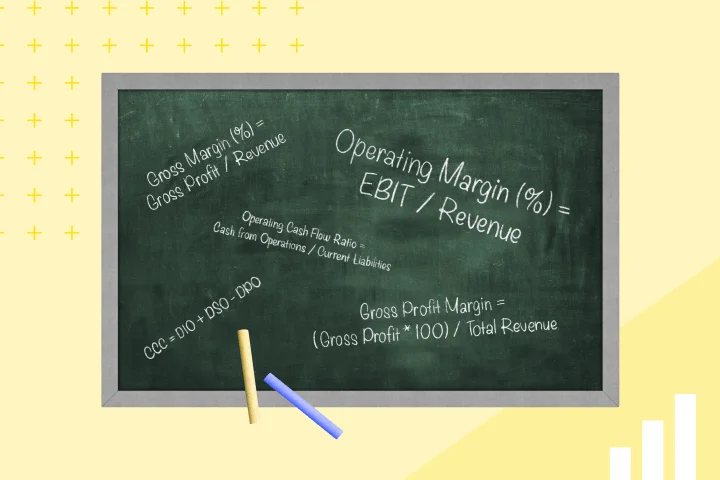The month-end close process is a vital function of the accounting department. It allows you to generate accurate financial statements for strategic planning and informed business decisions.
Closing your books can be a tedious and stress-inducing process, even for experienced accountants. Your finance team has to balance their regular duties with this additional work, which can sometimes require them to work late to complete everything on schedule.
But your month-end close doesn’t have to be a headache. Below, you’ll find some tips and tools to help you make this process painless, efficient, and successful every month.
Key Steps of the Month-End Close Process
- Gather your financial data: Collect all relevant financial data before you begin, such as bank statements, credit/debit transactions, bills, POS reports, and payroll data.
- Review accounts payable and receivable: Check AR and AP ledgers to make sure that there are no past due balances that should be written off or unapplied credits.
- Reconcile accounts: Complete reconciliations for all applicable accounts—including bank accounts, inventory, credit card accounts, loans, and other asset or liability accounts—and resolve discrepancies as they arise.
- Consider inventory and fixed assets: Verify inventory and fixed assets each month to ensure that your books reflect the actual balances of these accounts.
- Collate financial statements: Generate and prepare financial statements for a final review.
- Conduct a final review: Examine the financial statements for accuracy and investigate any irregularities.
- Prepare for the following month: Continuously learn from the process and make improvements to prepare for the next month’s closing.
High-Level Month-End Close Process Flowchart
The month-end close process usually takes 5-10 days to complete, depending on the size and complexity of your company and financial data. That means you could spend up to a third of the month on this process, consuming valuable company time and resources. The following flowchart can help you keep it streamlined and consistent. Keep in mind that each step comprises multiple tasks.
Month-End Close Process Checklist
Each account in your chart of accounts must be reviewed monthly for errors, changes, and accuracy. Here are the steps you’ll need to follow to close your books, keeping in mind that any irregularities or discrepancies will require investigation.
Cash
Adjust cash accounts for outstanding checks and deposits. Make sure there are no undeposited funds from prior periods. All cash and cash equivalent accounts should match the balance on your statements.
Accounts Payable & Receivable
Look for any past-due balances that may need to be written off and unapplied credits that can be used. The Accounts Receivable and Accounts Payable Aging Statement balances should agree with the trial balance.
Inventory & Fixed Assets
Perform a physical inventory count and adjust for damage, spoilage, or other variances. Record depreciation on fixed assets, and ensure that sales and acquisitions transactions have been captured.
Intercompany Accounts
Intercompany payables and receivables should be the same on both businesses’ books. Business A’s payable to Business B should match Business B’s receivable from Business A.
Accrued Taxes
Verify that taxes have been accrued for any taxes you’re required to pay, such as property, sales, and payroll taxes. There should be an accrual and corresponding expense entry.
Accrued Vacation & Payroll
Check to make sure that any wages or salary earned since the last pay period have been accrued. Earned vacation or sick time should be accrued, and unused time should remain on your books as a liability.
Expenses
Review expenses to see if any purchases need to be capitalized. Revisit Miscellaneous Expense to see if any transactions can be categorized more appropriately.
Notes Receivable & Payable to Bank
Reconcile notes and loans receivable and payable to ensure that your loan balance is correct and interest income or expenses have been recorded.
Undeposited Funds
The Undeposited Funds balance should reflect only checks and deposits that haven’t cleared your bank in the current period. Any transactions remaining in the account from prior periods should be investigated to find out why they haven’t cleared.
Equity
The balance in Retained Earnings should reflect the amount reported on the prior year’s tax return. Any personal expenses or withdrawals by owners should be accurately recorded. There should also be a zero balance in Opening Balance Equity.
Common Pitfalls
There are many challenges and bottlenecks your accounting and finance team might encounter while closing the books. An inefficient data-gathering process can consume valuable time and resources. And coordinating work between various functions—like HR, Procurement, and Finance—requires exceptional communication.
Managing time and resources and human error are two of the biggest challenges that accounting teams face during this process. Inefficient procedures and manual processes strain the finance department’s ability to effectively organize its time and resources. On top of that, human error can significantly impact the accuracy of your financial statements and the whole month-end close process.
How to Prepare for a Successful Month-End Close
Monthly close is one of the most challenging times for finance teams. With so much work often condensed into several hectic days at the end of the month or a given financial period, it can be a weight not just on finance teams but across a business.
Accelerating this process comes down to implementing the right techniques and strategies — before that hectic time arrives. So, here are four things you can do to close the month faster.
Get all teams on board
Monthly close involves information and data from across the business and can include all the teams in your organization. The first step to accelerate this process is to make sure that the key stakeholders and team leaders are on board with the process. Help them understand what they need to deliver to the finance team and when, with clear deadlines and processes in place for them to deliver that information.
The key is communication and expressing how accelerating monthly close will drive benefits for the entire organization. If it simply feels like busy work, teams might not commit, but if they understand that accelerating the process will help the company achieve its goals, teams will make the effort.
Optimize for closing
If you have buy-in from the rest of the organization, now is the time to think about how you can optimize workflows and processes across your business to help your finance team accelerate your close. Start with visibility, whether through shared calendars, or utilizing your company’s project management tools, so that key deadlines are clear to everyone.
Second, make sure your tools are working together and especially with your ERP. Look at the resources provided by your ERP and make sure you are taking advantage of them. Your ERP is one of the most critical platforms for finance teams, so make sure you are building workflows optimized for whichever platform you have selected.
Lastly, take a look at how much of your monthly close is still dependent on legacy tools. It seems that no matter the team or task, there is always someone using a spreadsheet. While spreadsheets still have their role and their simplicity and familiarity can be attractive, new tools are constantly being developed that can often serve your team much more efficiently.
Embrace continuous accounting
This new approach to managing finances aims to replace the idea of one concentrated period of reconciliation and close with a constant process spread over the entirety of the month or financial period. It relies heavily on automation of repetitive tasks to accelerate the close at the end of the period.
The method, which is also called Continuous Close, needs to be implemented into your workflow and that means you also need to have the right tools to support it. Netsuite, the widely used ERP, has resources available for its users to begin working according to this model.
Here at Mesh, we believe that continuous accounting can offer major benefits for finance teams and this has been one of the philosophies driving our solution. Mesh, for example, helps to automate the collection and matching of receipts so that this process doesn’t need to be concentrated at the end of the month.
Be flexible
No matter how many steps you take to make the monthly close faster, surprises happen. Not everything will go according to plan. For that reason, it’s important to build flexibility into your processes. That could mean budgeting more time than you estimate is necessary, or simply structuring your finance team in such a way that they can step in when an extra effort is needed.
A faster monthly close is an important part of achieving your business goals, but it shouldn’t come at the expense of something else. Building in flexibility will help you achieve the right balance of speed while still making sure you close the books correctly.
Tips For a More Efficient Month-End Close Process
1. Consolidate Transactions
You’ll often have transaction data coming from multiple sources, like your bank, credit card accounts, and POS system. Collecting this data from various platforms at the end of each month is tedious and inefficient. Consider integrating your systems to consolidate your transactions as much as possible.
2. Leverage Templates and Checklists
Organizing your work into templates and checklists will keep you organized and boost efficiency. Use templates for inventory counts, reconciliations, or financial reports to reduce the time spent on these tasks. Checklists can keep you on track and ensure you don’t miss any critical tasks.
3. Implement Company Cut-Offs
To ensure accurate data for your financial reports and eliminate the need for corrections, set a company-wide cut-off date and communicate it to your team. For example, inventory is constantly changing, so implementing a cut-off date will allow you to get an accurate count for your reports.
4. Back Up Your Data
All your data should be stored safely in the cloud or on a reliable local system and backed up regularly. Backing up your data allows you to reference previous months’ data, generate accurate financial reports, and prepare for audits and tax obligations.
5. Implement Automated Systems
Accounting automation systems will increase the speed and efficiency of your month-end close process. Repetitive manual tasks like transaction categorization can be eliminated, saving your team hours of valuable time. Multiple team members can work simultaneously, and tasks can be handed off more efficiently.
Book a demo to see how automation can transform your financial processes.
Speed Up Your Month-End Close Process
We hope this checklist and the above tips can help you implement a smoother, more efficient month-end close for your finance team. Investing in automated solutions and integrations can save you both time and effort in closing your books every month while reducing the risk of human error and boosting your team’s efficiency.
FAQs
The month-end close process is important for generating accurate financial statements, aiding strategic planning, and making informed business decisions.
Key steps include gathering financial data, reviewing accounts payable and receivable, reconciling accounts, considering inventory and fixed assets, collating financial statements, conducting a final review, and preparing for the following month.
The process typically takes 5-10 days, depending on company size and complexity.
Common pitfalls include inefficient data gathering, coordination challenges between departments, and the potential for human error impacting financial statement accuracy.
Prepare by establishing clear deadlines and processes, optimizing workflows, embracing continuous accounting, and building flexibility into processes.
Tips include consolidating transactions, using templates and checklists, implementing cut-off dates, backing up data, and utilizing automated systems for streamlined tasks and improved productivity.
-
Get the latest blogs from Mesh by subscribing to our newsletter







